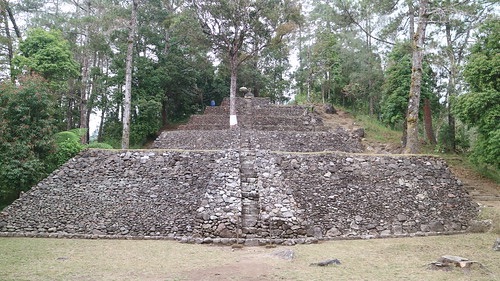The Candi Kethek Pyramid is a lesser-known historical site located in Indonesia. It is a structure that reflects the country’s rich cultural heritage and complex history. The pyramid is part of a larger group of temples and archaeological sites that showcase the influence of Hindu and Buddhist cultures in the region. Despite its name, the Candi Kethek is not a pyramid in the traditional sense but rather a temple that bears a pyramidal shape. Its origins and purpose have intrigued historians and archaeologists, leading to various theories and interpretations.
Get your dose of History via Email
Historical Background of Candi Kethek Pyramid
The Candi Kethek Pyramid’s discovery remains shrouded in mystery. There is little documentation on when and by whom it was first uncovered. However, it is known that the structure is a product of the ancient Javanese kingdoms. These kingdoms were known for their impressive temple construction. The Candi Kethek was likely built during the 8th to 9th centuries, a period marked by the proliferation of Hindu and Buddhist temples in Central Java.
Historians attribute the construction of the Candi Kethek to the Mataram Kingdom, a powerful dynasty that contributed significantly to the temple-building culture in Java. The kingdom’s influence is evident in the architectural styles of the region’s temples. The Candi Kethek, with its intricate carvings and design, is no exception. It stands as a testament to the kingdom’s architectural prowess and religious devotion.
Over the centuries, the Candi Kethek Pyramid has seen various phases of use and abandonment. After the decline of the Mataram Kingdom, the temple was likely neglected and eventually reclaimed by the surrounding jungle. It wasn’t until much later that the site would be rediscovered and studied by historians and archaeologists.
While the Candi Kethek may not have been the scene of any historically significant events, its existence offers valuable insights into the religious and cultural practices of ancient Java. The temple’s design and decorations suggest that it was a place of worship and spiritual significance for the people of the Mataram Kingdom.
Today, the Candi Kethek Pyramid is an important cultural landmark. It attracts scholars and tourists alike, who are drawn to its historical significance and architectural beauty. The site continues to be a subject of research, as experts work to uncover more about its origins and the civilization that built it.
About Candi Kethek Pyramid
The Candi Kethek Pyramid is a striking example of ancient Javanese temple architecture. It is characterized by its stepped, pyramidal form, which is typical of Hindu temples in the region. The structure is built from andesite, a type of volcanic rock commonly used in temple construction during the period. This material was favored for its durability and the fine detail it allowed artisans to carve into it.
The temple’s design includes a series of terraces leading to the top, where a main chamber likely housed a deity or an important religious artifact. The walls of the Candi Kethek are adorned with intricate bas-reliefs, which depict scenes from Hindu mythology and teachings. These carvings not only serve a decorative purpose but also convey the religious and philosophical beliefs of the temple’s builders.
One of the architectural highlights of the Candi Kethek is its elaborate entrance, which features a Kala head carving. This motif is common in Javanese temple architecture and symbolizes protection and the swallowing of evil spirits. The entrance sets the tone for the sacred space within, inviting worshippers to leave the mundane world behind as they enter the temple.
The construction methods of the Candi Kethek Pyramid reflect the advanced engineering skills of the Mataram Kingdom. The temple was built without the use of mortar, relying instead on a precise interlocking of stone blocks. This technique ensured the structure’s stability and has allowed it to withstand the test of time.
Despite the temple’s resilience, the tropical climate and seismic activity in the region have taken their toll. Conservation efforts are ongoing to preserve the Candi Kethek for future generations. These efforts are crucial in maintaining the site’s structural integrity and the wealth of historical information it holds.
Theories and Interpretations
The purpose of the Candi Kethek Pyramid has been the subject of various theories. Most scholars agree that it served a religious function, likely as a Hindu temple. The presence of Hindu iconography supports this interpretation. However, the specific deity or deities worshipped at the temple remain unknown.
Some theories suggest that the Candi Kethek was part of a larger complex of temples and served a specific role within a broader religious landscape. Its placement and orientation with respect to other nearby temples may have had astronomical or cosmological significance, guiding the design and construction of the site.
The mysteries of the Candi Kethek extend to its name, which translates to “monkey temple” in Javanese. The origin of this name is unclear, but it may be linked to the temple’s decorations or to local legends and folklore. This aspect of the temple’s history continues to intrigue both locals and scholars.
Dating the Candi Kethek has been challenging due to the lack of inscriptions or historical records directly associated with the temple. However, stylistic analysis and comparisons with other known structures from the period have provided estimates for its construction. Radiocarbon dating and other scientific methods have also been employed to narrow down the timeframe of its origins.
Interpretations of the Candi Kethek’s carvings and architecture have had to be matched to historical records and religious texts from the period. This process has helped historians piece together a more complete picture of the temple’s significance and the beliefs of those who built it.
At a glance
Country: Indonesia
Civilization: Mataram Kingdom
Age: 8th to 9th centuries AD
Conclusion and Sources
Reputable sources used in the creation of this article include:
- Wikipedia: https://en.wikipedia.org/wiki/Candi_of_Indonesia
- Wikipedia: https://en.wikipedia.org/wiki/Candi_Kethek

